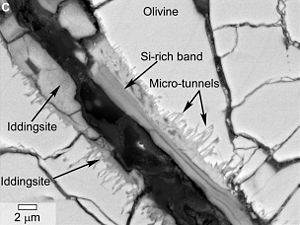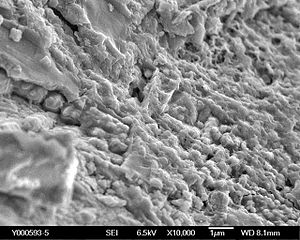Yamato 000593
| Yamato 000593 | |
|---|---|
 Yamato 000593 meteorite—13.7 kg (30 lb). The cube is 1 cm (0.39 in) (NASA; 2012). | |
| Type | Achondrite |
| Structural classification | Igneous[1] |
| Class | Martian meteorite[2] |
| Group | Nakhlite[2] |
| Composition | pyroxene 85% [1] olivine 10% |
| Shock stage | S3[1] |
| Weathering grade | B[3] |
| Country | Antarctica[2] |
| Region | Yamato Glacier[2] |
| Coordinates | 71°30′S 35°40′E / 71.500°S 35.667°E [3][4] |
| Observed fall | No |
| Fall date | 50,000 years ago[2] |
| Found date | 2000[2] |
| TKW | 13.7 kg (30 lb)[2] |
Yamato 000593 (or Y000593) is the second largest meteorite from Mars found on Earth.[2][5][6] Studies suggest the Martian meteorite was formed about 1.3 billion years ago from a lava flow on Mars.[7] An impact occurred on Mars about 11 million years ago[7] and ejected the meteorite from the Martian surface into space. The meteorite landed on Earth in Antarctica about 50,000 years ago. The mass of the meteorite is 13.7 kg (30 lb) and has been found to contain evidence of past water alteration.[2][5][6][8]
At a microscopic level, spheres are found in the meteorite rich in carbon compared to surrounding areas lacking such spheres. The carbon-rich spheres and the observed micro-tunnels may have been formed by biotic activity, according to NASA scientists.[2][5][6]
Discovery and naming
[edit]The 41st Japanese Antarctic Research Expedition (JARE) found the meteorite in late December 2000 on the Yamato Glacier in the Queen Fabiola Mountains, Antarctica.[2][9]
Description
[edit]The mass of the meteorite is 13.7 kg (30 lb).[2] It is an unbrecciated cumulus igneous rock consisting predominantly of elongated augite crystals—a solid solution in the pyroxene group.[9] Japanese scientists from the National Institute of Polar Research reported in 2003 that the meteorite contains iddingsite, which forms from the weathering of basalt in the presence of liquid water.[9] In addition, NASA researchers reported in February 2014 that they also found carbon-rich spheres encased in multiple layers of iddingsite, as well as microtubular features emanating from iddingsite veins displaying curved, undulating shapes consistent with bio-alteration textures that have been observed in terrestrial basaltic glass.[2] However, the scientific consensus is that "morphology alone cannot be used unambiguously as a tool for primitive life detection."[10][11][12] Interpretation of morphology is notoriously subjective, and its use alone has led to numerous errors of interpretation.[10] According to the NASA team, the presence of carbon and lack of corresponding cations is consistent with the occurrence of organic matter embedded in iddingsite.[5] The NASA researchers indicated that mass spectrometry may provide deeper insight into the nature of the carbon, and could distinguish between abiotic and biologic carbon incorporation and alteration.[5]
Classification
[edit]The Martian meteorite is an igneous rock classified as an achondrite type of the nakhlite group.[2][1]
Images
[edit]See also
[edit]References
[edit]- ^ a b c d Yamato meteorite (PDF) The Astromaterials Acquisition and Curation Office, NASA.
- ^ a b c d e f g h i j k l m n Webster, Guy (February 27, 2014). "NASA Scientists Find Evidence of Water in Meteorite, Reviving Debate Over Life on Mars". NASA. Retrieved February 27, 2014.
- ^ a b "Meteoritical Bulletin Database - Yamato 000593". The Meteoritical Society. Lunar and Planetary Institute. February 26, 2014. Retrieved February 28, 2014.
- ^ Yamato 000593 Natural History Museum, UK. The Catalogue of Meteorites.
- ^ a b c d e White, Lauren M.; Gibson, Everett K.; Thomnas-Keprta, Kathie L.; Clemett, Simon J.; McKay, David (February 19, 2014). "Putative Indigenous Carbon-Bearing Alteration Features in Martian Meteorite Yamato 000593". Astrobiology. 14 (2): 170–181. Bibcode:2014AsBio..14..170W. doi:10.1089/ast.2011.0733. PMC 3929347. PMID 24552234.
- ^ a b c Gannon, Megan (February 28, 2014). "Mars Meteorite with Odd 'Tunnels' & 'Spheres' Revives Debate Over Ancient Martian Life". Space.com. Retrieved February 28, 2014.
- ^ a b Cohen, Benjamin E.; Mark, Darren F.; Cassata, William S.; Lee, Martin R.; Tomkinson, Tim; Smith, Caroline L. (2017-10-03). "Taking the pulse of Mars via dating of a plume-fed volcano". Nature Communications. 8 (1): 640. Bibcode:2017NatCo...8..640C. doi:10.1038/s41467-017-00513-8. ISSN 2041-1723. PMC 5626741. PMID 28974682.
- ^ Mikouchi, T.; E. Koizumi; A. Monkawa; Y. Ueda (March 2003). "Mineralogy and petrology of Yamato 000593: Comparison with other Martian nakhlite meteorites". Antarctic Meteorite Research. 16: 34–57. Bibcode:2003AMR....16...34M.
- ^ a b c Imae, N.; Y. Ikeda; K. Shinoda; H. Kojima; Iwata, Naoyoshi (2003). "Yamato nahklites: Petrography and mineralogy". Antarctic Meteorite Research. 16: 13–33. Bibcode:2003AMR....16...13I.
- ^ a b Garcia-Ruiz, Juan-Manuel Garcia-Ruiz (December 30, 1999). "Morphological behavior of inorganic precipitation systems". In Hoover, Richard B. (ed.). Instruments, Methods, and Missions for Astrobiology II. Vol. Proc. SPIE 3755. pp. 74–82. doi:10.1117/12.375088. S2CID 84764520.
It is concluded that "morphology cannot be used unambiguously as a tool for primitive life detection."
{{cite book}}:|journal=ignored (help) - ^ Agresti; House; Jögi; Kudryavstev; McKeegan; Runnegar; Schopf; Wdowiak (December 3, 2008). "Detection and geochemical characterization of Earth's earliest life". NASA Astrobiology Institute. NASA. Retrieved January 15, 2013.
- ^ Schopf, J. William; Kudryavtsev, Anatoliy B.; Czaja, Andrew D.; Tripathi, Abhishek B. (April 28, 2007). "Evidence of Archean life: Stromatolites and microfossils" (PDF). Precambrian Research. 158 (3–4): 141–155. Bibcode:2007PreR..158..141S. doi:10.1016/j.precamres.2007.04.009. Retrieved January 15, 2013.
External links
[edit]- Yamato meteorite (PDF) The Astromaterials Acquisition and Curation Office, NASA.



